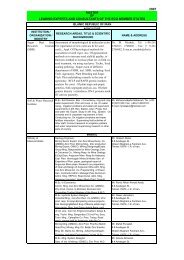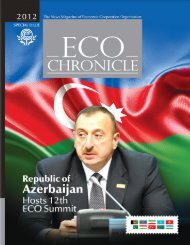ECO-IEST President, Alternative Member to the IPBES Bureau
ECO-IEST President, Alternative Member to the IPBES Bureau
ECO-IEST President, Alternative Member to the IPBES Bureau
You also want an ePaper? Increase the reach of your titles
YUMPU automatically turns print PDFs into web optimized ePapers that Google loves.
Trade &<br />
Investment<br />
ticity of demand, and <strong>the</strong> relative lack of constraints from <strong>the</strong><br />
cropped area. Growth in demand for dairy products in Pakistan<br />
is estimated at 5.5% per year. Demand for lives<strong>to</strong>ck products is<br />
increasing because of population growth rate and increased<br />
income levels. Most milk production continues <strong>to</strong> be channeled<br />
<strong>to</strong> <strong>the</strong> market through traditional networks. Moreover, <strong>the</strong> milk<br />
yield is also low which can be attributed <strong>to</strong> a poor genetic pool<br />
and inappropriate feeding and farm management. Significant<br />
productivity gains can be achieved through better farm-management<br />
practices, improved feeds, better veterinary services, and<br />
improved marketing channels. Poultry sec<strong>to</strong>r is also one of <strong>the</strong><br />
progressive segments of agriculture industry of Pakistan. This sec<strong>to</strong>r<br />
generates (direct/indirect) employment for about 1.5 million<br />
people. Its contribution in agriculture growth is 4.81%. Poultry<br />
meat contributes 19% of <strong>the</strong> <strong>to</strong>tal meat production in <strong>the</strong> country.<br />
The existing daily availability of protein quantity per capita in<br />
Pakistan deriving from animal source amounts <strong>to</strong> 13.6 grams.<br />
This is far less than <strong>the</strong> recommended daily dietary protein<br />
allowance from animal source of 27 grams. According <strong>to</strong> industry<br />
sources <strong>the</strong>re is capacity of 5,000 Environmental Control<br />
Houses in Pakistan and currently around 2,500 houses are working.<br />
The poultry meat production has showed a growing trend<br />
over <strong>the</strong> past few years which is now close <strong>to</strong> 0.65 million <strong>to</strong>ns<br />
annually. Pakistan annually produces about 13.7 million <strong>to</strong>ns of<br />
fruits and vegetables. Citrus fruit has taken <strong>the</strong> lead in term of<br />
production followed by mango, dates and guava. Pota<strong>to</strong> and<br />
onion lead among vegetables and condiments. The <strong>to</strong>tal area<br />
devoted <strong>to</strong> fruit and vegetable production has increased rapidly<br />
in recent years, reaching 1.5 million hectares<br />
(ha). Citrus, with <strong>to</strong>tal production of 2.1 million<br />
<strong>to</strong>ns, is <strong>the</strong> largest horticulture crop<br />
group by volume, and a major foreign<br />
exchange earner, along with mangoes and<br />
dates. The horticulture sec<strong>to</strong>r in Pakistan represents<br />
tremendous unrealized potential that requires a<br />
systematic and focused intervention. This<br />
would help <strong>the</strong> country <strong>to</strong> get a sizeable share<br />
in <strong>the</strong> global market of USD 80 bln.<br />
Horticulture has been estimated <strong>to</strong> have an<br />
annual growth potential of around 8%. Pakistan is<br />
losing millions of dollars annually in citrus exports<br />
because of <strong>the</strong> absence of basic infrastructure, transportation<br />
facilities, deficiencies in s<strong>to</strong>rage, credit systems,<br />
gaps in <strong>the</strong> cold chain and limited cold s<strong>to</strong>rage capacity.<br />
Only 10% of Pakistan's produce, in case of fruits, is<br />
exported due <strong>to</strong> inadequate cold s<strong>to</strong>rage facilities.<br />
Modern agriculture requires expensive infrastructure<br />
including roads, irrigation, and electrification. Pakistan<br />
Investment Opportunities<br />
44% of country's workforce and is a major source of foreign<br />
exchange earnings. Approximately 67% of <strong>the</strong> country's population<br />
lives in rural areas and directly or indirectly relies on <strong>the</strong><br />
agricultural sec<strong>to</strong>r for its livelihood.<br />
Wheat, rice, cot<strong>to</strong>n, and sugarcane are considered <strong>to</strong> be <strong>the</strong><br />
major crops and contribute around 6.5% <strong>to</strong> <strong>the</strong> overall GDP.<br />
Wheat is grown over 8.41 million ha, rice over 2.52 million ha<br />
and cot<strong>to</strong>n about 3.05 million ha. The cropped area for rice is<br />
growing steadily; however, <strong>the</strong>re is decreasing trend is observed<br />
in sugarcane plantation. Food crops account for about 70% of<br />
<strong>the</strong> cropped area. Cash crops (cot<strong>to</strong>n, sugarcane, <strong>to</strong>bacco, etc.)<br />
provide basic inputs for key industries, particularly textiles.<br />
Pakistan is <strong>the</strong> world's fourth largest producer and consumer of<br />
cot<strong>to</strong>n. The share of crop sub-sec<strong>to</strong>r has gradually declined from<br />
65% of agricultural activity in 1990-91 <strong>to</strong> 45.4% in 2008-09.<br />
By contrast, <strong>the</strong> share of lives<strong>to</strong>ck in agriculture has increased<br />
from 30% <strong>to</strong> over 50% during <strong>the</strong> same period. Lives<strong>to</strong>ck and<br />
dairy sub-sec<strong>to</strong>rs account for around 38% of agriculture<br />
value added. About 38 million people of rural areas<br />
(involving 6 million farms) are engaged in raising lives<strong>to</strong>ck<br />
and deriving 30-40% of <strong>the</strong>ir<br />
incomes from this activity.<br />
Pakistan is <strong>the</strong> fourth largest producer<br />
of milk in <strong>the</strong> world, producing over 40<br />
million <strong>to</strong>nnes of milk annually of which<br />
only a small fraction is processed. There<br />
are approximately 6 million small dairy<br />
farmers in Pakistan. Lives<strong>to</strong>ck has good<br />
growth potential owing <strong>to</strong> its large base, its high income elas-<br />
needs <strong>to</strong> invest in <strong>the</strong> irrigation infrastructure placing emphasis<br />
on farmer organizations <strong>to</strong> ensure efficient use of water and adequate<br />
maintenance. Some experts believe that <strong>the</strong> banking sec<strong>to</strong>r<br />
must provide, for medium <strong>to</strong> long term, an annual credit <strong>to</strong><br />
<strong>the</strong> extent of USD 17 bln per annum for a sustained growth of<br />
6% in <strong>the</strong> agriculture sec<strong>to</strong>r. The USD 2.5 bln targeted credit for<br />
2008-09 fell way short of that mark. Even this was mostly concentrated<br />
on short term production/ working capital farm credit.<br />
The Bank would support investments <strong>to</strong> build s<strong>to</strong>rage facilities,<br />
cold chain infrastructure, and o<strong>the</strong>r ventures <strong>to</strong> support value<br />
addition in <strong>the</strong> agriculture sec<strong>to</strong>r. It would actively seek <strong>to</strong><br />
finance industrial projects that use agriculture produce as raw<br />
materials.<br />
ii)Infrastructure<br />
Pakistan's physical infrastructure is inadequate in comparison<br />
with o<strong>the</strong>r rapidly developing emerging economies and has<br />
been cited as one of <strong>the</strong> major reasons holding back rapid economic<br />
growth in <strong>the</strong> country.<br />
<strong>ECO</strong> CHRONICLE<br />
43















